Note: for the full suite of measurements from the SoundStage! Audio-Electronics Lab, click this link.
Rotel has introduced a number of integrated amplifiers in the past couple of years, a few of which have been reviewed here on the SoundStage! Network; from the very high-end Michi X5 ($7499, all prices in USD) to the entry-level A11 Tribute ($799.99) and several in between. Aside from the Michi range, the company is known as a manufacturer of cost-effective, high-value products. However, to celebrate its 60th anniversary, Rotel has introduced two premium Diamond Series components: the RA-6000 integrated amplifier-DAC ($4499), the subject of this review, and the DT-6000 CD player–DAC ($2299, review forthcoming).
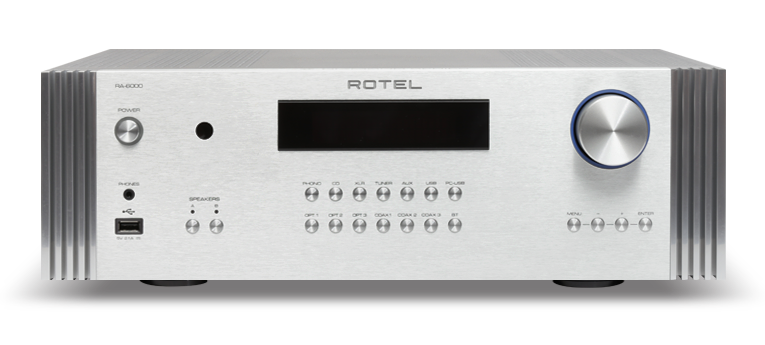
Reviewing the Michi X5 and Rotel’s RA-1572MKII ($2099) had been positive experiences, so I readily agreed to review both of the new Diamond Series components. Rotel’s Canadian distributor, Kevro International, arranged to have them shipped to me and then to our electronics measurement specialist, Diego Estan, to perform an extensive suite of test measurements.
A Diamond, not so much in the rough
The RA-6000 is unmistakably a Rotel product, with its available black or silver finishes, centrally located dot-matrix display, and classic rows of round pushbuttons, but the usual cosmetics have been upgraded somewhat and the build quality is more substantial. While it looks similar to the RA-1572MKII I previously reviewed, closer inspection revealed a thicker front faceplate with an attractive, silvery, brushed-aluminum finish. And instead of rounded end caps, it has similarly thick and deeply grooved chrome end caps that give the amp a more muscular and angular look. The heftier buttons and volume control are made of machined aluminum to add to the beefier appearance, and the top surface is engraved with the words “DIAMOND SERIES.”
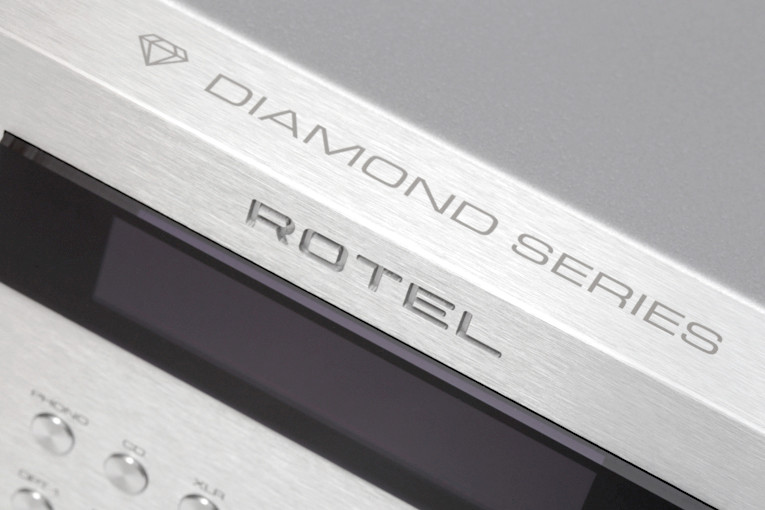
The dot-matrix display appears to be the same as those found on some other RA Series integrated amplifier-DACs, with the ability to display a lot of information, but with relatively small characters that are difficult to read from across the room. It is able to simultaneously display the input, volume level, bit rate, sampling frequency, and the type of signal being received, such as PCM or MQA. Below the display are two rows of round buttons allowing direct selection of inputs; to the left, buttons with LED indicators to select speakers A and B; and to the right and below the volume knob, buttons to access the menu system. Also situated on the left are the IR sensor for the remote, a 3.5mm headphone jack, a standby power button with a blue LED indicator, and a USB Type-A input that Rotel says is compatible with most Apple iOS devices.
The back panel is logically and neatly arranged with the top row of digital inputs comprising three TosLink optical and three RCA coaxial S/PDIF connections, an ethernet port, a USB Type-B port (labeled “PC-USB”), and a plastic-covered Bluetooth antenna. Below is an extensive row of analog RCA connections—MM stereo phono input with ground, three stereo line-level inputs, a pair of mono subwoofer outputs, a set of preamplifier outputs—and a single set of analog XLR inputs. The bottom row consists of two sets of speaker binding posts with speakers A placed to the right and speakers B to the left. On the extreme left of the panel are the standard two-prong IEC power inlet, an RS232 port, two 12V trigger outputs, and an input for an external remote sensor. The unit measures 17″W × 6″H × 16″D and weighs a very solid 41.5 pounds.
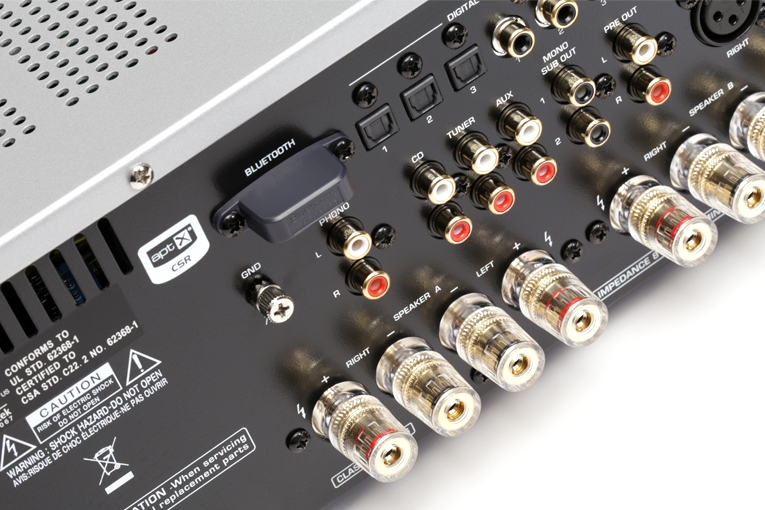
The interior is also constructed in a neat and tidy manner, but is jam-packed with multiple boards, including a DAC section featuring TI’s PCM5242 32-bit/384kHz DAC chip. Both the coaxial and optical digital inputs support PCM data with resolutions up to 24/192, and the back-panel USB-B input supports up to 32/384 data, but does not support DSD. The RA-6000 unfolds and renders MQA and MQA Studio, and is Roon Tested. For convenience, the amp also supports aptX HD and AAC Bluetooth, which I tested with a Samsung Galaxy S9, but did not utilize for critical listening. I also tried the front-panel iOS USB-A input; the display indicated the amp was receiving 24/44.1 data no matter what I played from the Apple Music or Tidal apps on an iPhone 6S.
As with all Rotel products, inside the unit, near the front, sits a massive, in-house-manufactured toroidal transformer; this one has the Diamond Series logo emblazoned on it. Large, finned internal heatsinks run nearly the entire length of each side. The top cover seems to be of heavier gauge metal than with most Rotel products, but is not as substantial as used in the massive and heavily built Michi products with their curved edges and high-quality matte finishes. Still, the purposeful appearance of the RA-6000 with its classic Rotel look should appeal to fans of the brand.
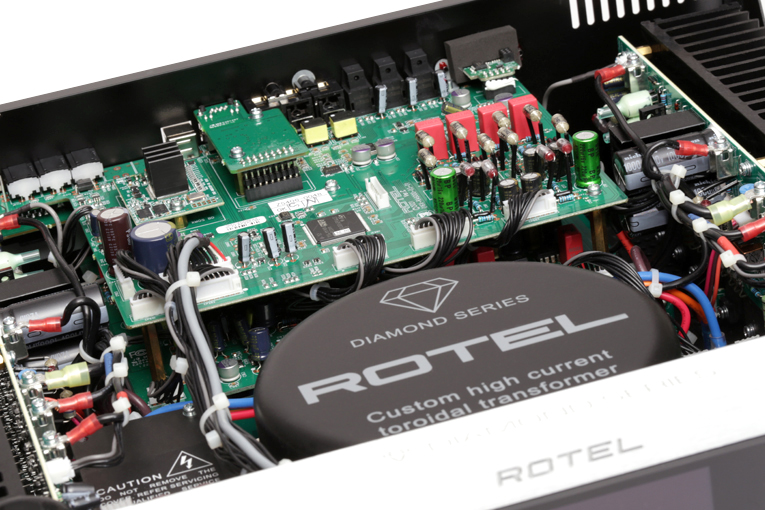
Power output is rated by the manufacturer as 200Wpc into 8 ohms or 350Wpc into 4 ohms, with total harmonic distortion < 0.0075%, and a damping factor (20Hz to 20kHz, 8 ohms) of 600. The input sensitivity of the MM phono stage is 5.2mV/47k ohms, with a frequency response of 20Hz to 20kHz (±0.5dB) and a signal-to-noise ratio (IHF A-weighted) of 80dB. The digital section has a claimed frequency response of 10Hz to 90kHz (±2dB) and a signal-to-noise ratio (IHF A-weighted) of 102dB.
The backlit remote is plastic, but relatively chunky, and has many small, similar-looking buttons. While the sheer number of buttons is a little overwhelming at first, it does allow most functions to be accessed directly—inputs, bass, treble, balance, speaker selection, and mute, among others. There are buttons to control a CD player, but they did not work with the companion Diamond Series DT-6000 CD player–DAC. The menu system is accessible via the remote or buttons on the unit’s front panel and allows access to additional functions, such as home-theater bypass, fixed-volume settings, power-on settings including maximum volume, decoding of either 32-bit PCM or MQA via USB, and dimming for both the display and LED power indicators.
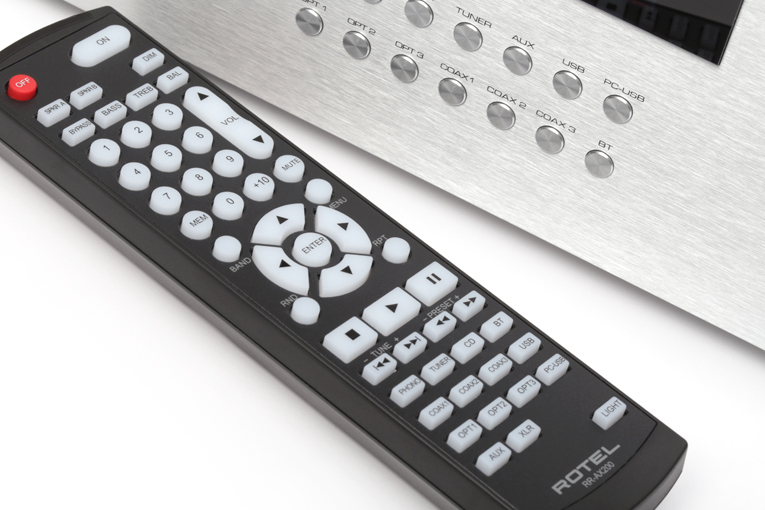
The RA-6000 may be relatively expensive for a Rotel product, but considering its impressive build quality and features, I did not think its price to be unreasonable. And compared to some of its similarly priced competitors, it is considerably more powerful and feature-rich.
Picking a setting for the Diamond
The RA-6000 was simple to set up and worked flawlessly during its extended stay in my reference system. As with other Rotel components I have recently reviewed, it requires installation of a custom USB 2.0 driver to support the maximum resolution of 32/384 when used with Windows computers. I downloaded and installed it from Rotel’s website as I had removed previous installations from my Intel NUC. As mentioned, I tested Bluetooth connectivity and the front-panel iOS input, but did not use them for critical listening. I also connected the DT-6000 to the analog XLR inputs and found the performance to be exceptional: however, I will save any detailed observations for my upcoming review of the DT-6000.
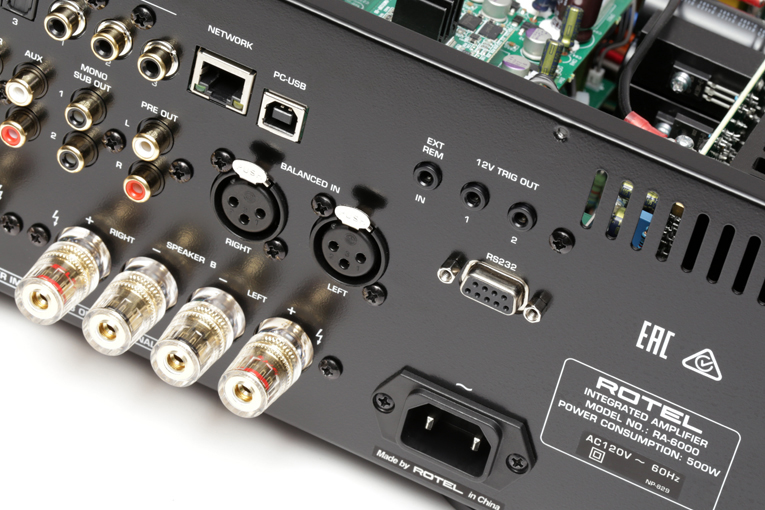
For most of my listening, I connected the RA-6000 to my NUC via the back-panel USB-B input to stream Tidal via Roon, and occasionally to play back locally stored files. I also connected my Pro-Ject X1 turntable with Pick it S2 cartridge to ascertain the quality of the MM phono stage. Accessories consisted of my usual assortment of cables from AudioQuest and Clarus to connect the components to my MartinLogan Masterpiece ESL 9 loudspeakers, and power cables and conditioning from ESP, Zero Surge, and Blue Circle Audio.
A righteous gemstone
The beefy-looking and powerful Diamond Series RA-6000 seemed right at home in my reference system and instilled in me a sense of confidence and security whenever I powered it up. This is something I rarely experience with the components I have reviewed in my system, but everything just seemed right whenever I used it. The RA-6000 isn’t as luxurious or as powerful as some of the high-end integrated amplifier-DACs I’ve used, but its confidence-inducing build quality was always complemented by a fantastic balance of sonic attributes.
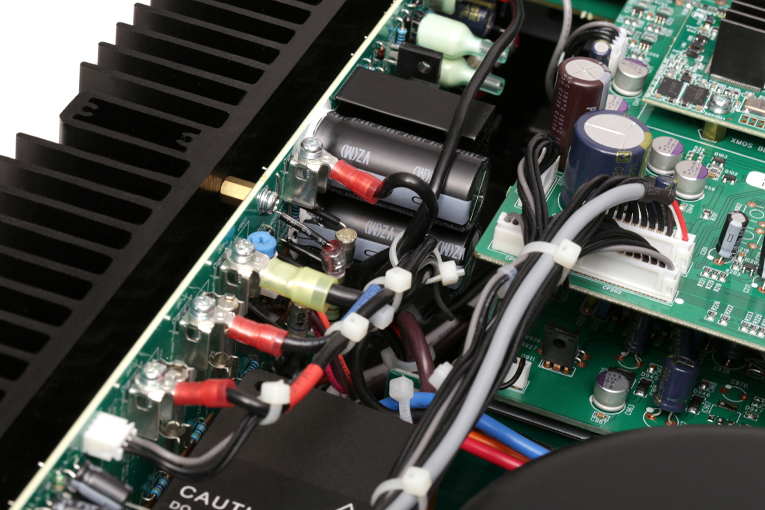
Peter Gabriel’s recently released single “Shock the Monkey: Earth Day Version—For EarthPercent” (24-bit/44.1kHz FLAC, EarthPercent) sounded excellent, even though it is not a modern remix, but an alternate, previously unreleased version of the song from 1982. The deep, pronounced male backing vocals at the beginning of the song give it a darker, more somber tone, but the RA-6000 was able to keep the slightly opaque mix wonderfully clean and funky-sounding. The frequently repeated chorus and synth riffs are even funkier than on the original mix, and the RA-6000 did a wonderful job of sorting out the dense rhythmic beats.
The straightforward rock’n’roll title track from Bryan Adams’s You Want It, You Got It (24/44.1 MQA, A&M Records / Tidal) also sounded clean and crisp. On “Lonely Nights,” each instrument in the basic arrangement of drums, guitar, bass, and keyboards was easily discernible, and the earnest and raw vocals of a very young Adams were laid bare with refreshing simplicity. And while this recording is far from reference quality, Adams’s brash guitar work came through with astonishing clarity. The Rotel amp conveyed the slashing guitar licks with all their intensity, and just enough edge to make them sound realistic while keeping them from becoming harsh or glaring.
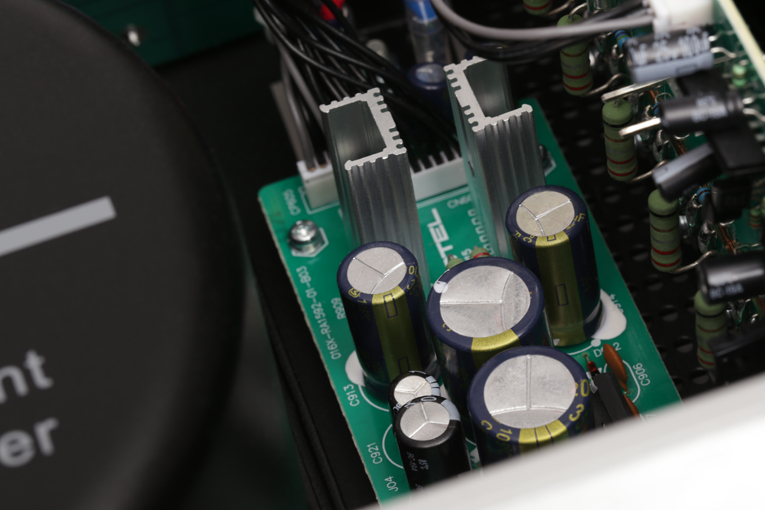
Listening to a more contemporary recording, Beyoncé and Madonna’s “Break My Soul (The Queens Remix)” (24/44.1 MQA, Columbia Records / Tidal), I was treated to a massive quantity of sound emanating from my MartinLogan ESL 9s; much like what I have heard from the very best integrated amps I have reviewed, and from my reference Anthem separates. The opening samples of Madonna’s “Vogue” were quickly infused with Beyoncé’s vocals; the entire soundstage was filled with a relaxed lushness that then turned to a more feverish pitch as the punchy beat bounced between the speakers. The rapid-fire, male-voice rapping sampled from Big Freedia’s “Explode” was crystal clear, and disappeared as quickly as it had appeared. It was followed by Beyoncé’s more atmospheric and echoing vocal overdubs, and the sound just kept coming at me in relentless waves. Each new wave was distinct from the one before, but I could hear each element smoothly decay away into nothingness through the many layers of sound with uncanny continuity. And while I was able to crank the volume incredibly high with the RA-6000, I didn’t feel the need, because the Rotel maintained a proper balance of the entire mix from relatively low levels all the way up to club-approved volumes.
As much fun as it was playing EDM tracks at high volumes, the RA-6000 was equally enjoyable when reproducing the unaccompanied piano on Lang Lang’s “Beauty and the Beast (Solo Version)” from The Disney Book: Deluxe Edition (24/192 MQA, Deutsche Grammophon / Tidal). From the virtuoso pianist’s faint opening notes to the full-bodied crescendos, the piano sprang to life. Placed directly between my speakers, it sounded as if it was in a much larger space that provided seemingly infinite sustain. I have been listening to Apple’s spatial audio recordings—including The Disney Book—on my Dolby Atmos–enabled system, and the sense of space that can be created with orchestral recordings makes many stereo recordings sound flat and uninspiring in comparison. With the orchestral version of “Beauty and the Beast,” featuring the Royal Philharmonic, the RA-6000 created a credible reproduction of the orchestra that provided a broad backdrop for the piano. Compared with the solo recording, the piano appeared to be smaller in scale, and in perfect proportion and orientation to the orchestra, even with this stereo version of the track.
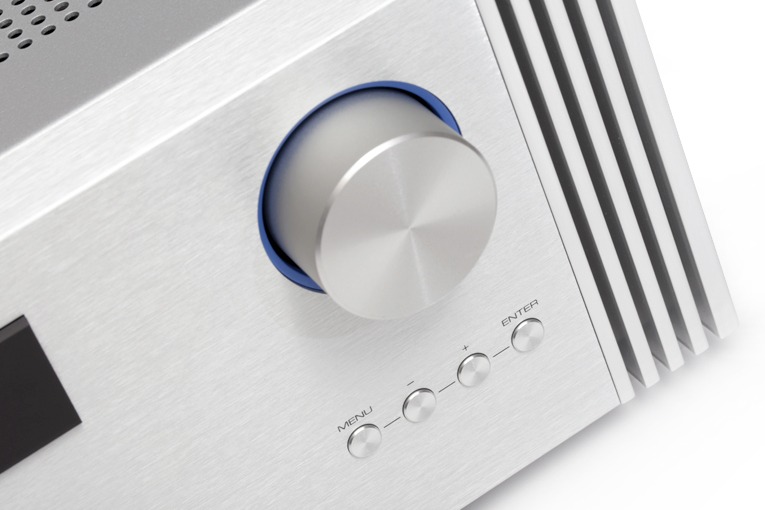
I thoroughly enjoyed my time with the RA-6000, which included listening to records through its excellent MM phono section. One of my recent favorites is The Police’s half-speed mastered Greatest Hits (Polydor ARHSDLP008). “Every Little Thing She Does Is Magic” was a fast-paced delight, with Stewart Copeland’s percussion spread evenly between the speakers. The frenzy of toms, cymbals, hi-hat, and kick drum provided amazing tempo, while the synth chords and Sting’s vocals were smooth and solidly centered. “Wrapped Around Your Finger” was wonderfully rich and liquid-sounding, with fantastic delineation of each element in the mix; from the more deliberate drum beat, to Sting’s brooding but polished vocals, and the tight twang of Andy Summers’s guitar. The presentation wasn’t quite as detailed or clean as that of the more expensive, DSP-enabled Technics SU-R1000 ($9499), or as silky smooth and rich as the Yamaha A-S3200 ($7499.95), but records still sounded as good as with any amplifier I have heard in the Rotel’s more modest price range.
Comparison
After listening to—and enjoying—the RA-6000 for an extended period of time, I replaced it with the Hegel Music Systems H120 integrated amp ($3200). Not surprisingly, the less expensive and lower-powered Hegel, while still sounding big and solid, could not separate out the massive waves of sound as distinctly on “Break My Soul (The Queens Remix).” Compared to the Rotel, there was less layering and depth, making the presentation a little shallower and less free-flowing. The machine-gun rapping also seemed less quick and incisive, and the bass beat was a bit lighter.
The headphone output of the Hegel was not quite as precise-sounding as that of the Rotel. Listening to the RA-6000 with my HiFiMan HE400se headphones, I was impressed by the articulation and control over these somewhat inefficient planar-magnetic cans. The quickly reverberating “Oh, oh” spoken by Fred Schneider on the B-52s’ “Roam [12″ Remix],” from Cosmic Thing: 30th Anniversary Expanded Edition (24/96 MQA, Rhino / Warner Bros. Records / Tidal), extended and decayed further away from where it originated than with the headphone output of my reference Oppo Digital UDP-205 4K Ultra HD universal Blu-ray player; the kick drum also had more weight through the Rotel. The backing vocals by Kate Pierson and Cindy Wilson were also less distinct from each other and from Schneider’s lead; with the Oppo, the voices blended together a little, while the Rotel presented them more as three separate entities.
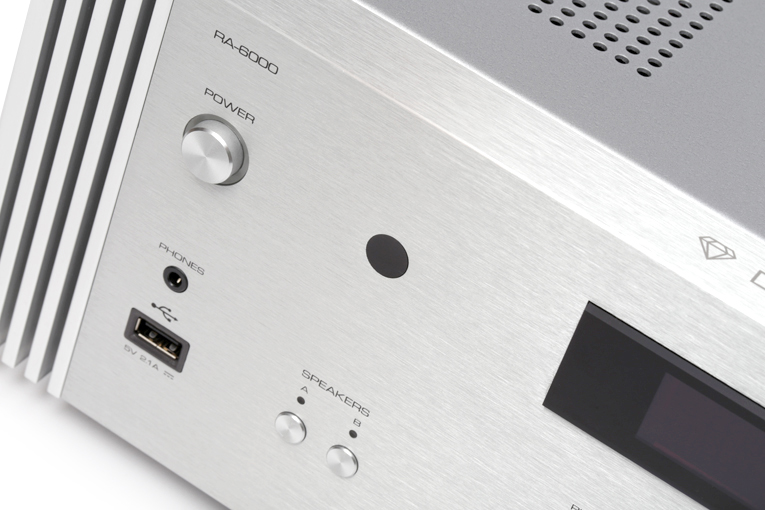
In many respects, the RA-6000 reminded me of Rotel’s statement Michi X5. It had more than enough power to drive my ESL 9s with ease, and a similarly neutral but smooth and satisfying sound. It has been a while since I’ve had the 350Wpc X5 in my system, but I didn’t feel that the lower-rated Diamond Series RA-6000 sounded any less powerful than the more expensive Michi. An interesting comparison would be with the Michi X3 ($5299), which I have not heard—it’s specified to output 200Wpc into 8 ohms, and has a similar feature set to the RA-6000.
My favorite integrated amplifier-DAC in this price range is still the NAD Masters M33 ($5999), which features 200Wpc of pristine power from its Purifi Eigentakt amplifier modules, Dirac Live room correction, and BluOS streaming capability. To my ears, Eigentakt-based amplifiers provide the most satisfying sound in this price range. However, this isn’t to say that there aren’t many other excellent-sounding, similarly priced integrated amplifiers, and the Eigentakt’s ultraclean sound might not suit everyone’s taste. The RA-6000 doesn’t have as many features as the M33, but it costs $1500 less and has a similar, if not quite as dead-neutral sound.
Diamond jubilee
The Rotel RA-6000 absolutely deserves to be considered one of the best integrated amplifier-DACs around the $5k price point. It may lack a couple of features, the most notable being a room-correction system, but if you don’t want or don’t need room correction, it offers a ton of performance and flexibility for the money. This new Diamond Series RA-6000 really takes Rotel’s classic amplification products to the next level of performance; updated, but still maintaining their familiar, classic look, and coming in at a price below that of Rotel’s highly regarded Michi products.
. . . Roger Kanno
rogerk@soundstagenetwork.com
Note: for the full suite of measurements from the SoundStage! Audio-Electronics Lab, click this link.
Associated Equipment
- Speakers: MartinLogan Masterpiece Classic ESL 9.
- Headphones: HiFiMan HE400se.
- Integrated amplifier-DAC: Hegel Music Systems H120.
- Digital sources: Intel NUC computer running Windows 10, Roon, and Tidal; AudioQuest JitterBug jitter reducer.
- Turntable: Pro-Ject Audio Systems X1 with Ortofon Pick it S2 cartridge.
- Speaker cables: Clarus Aqua Mark II.
- RCA interconnects: Clarus Aqua Mark II XLR, Pro-Ject Connect it E phono cable.
- USB link: AudioQuest Carbon.
- Power cords: Clarus Cable Aqua, Essential Sound Products MusicCord-Pro ES.
- Power conditioners: Blue Circle Audio PLC Thingee FX-2 with X0e low-frequency filter module, Zero Surge 1MOD15WI.
Rotel Diamond Series RA-6000 Integrated Amplifier-DAC
Price: $4499.
Warranty: Five years, parts and labor.
The Rotel Co. Ltd.
Tachikawa Building 1F
2-11-4, Nakane, Meguro-ku
Tokyo, Japan 152-0031
Email: sales@rotelglobal.com
Website: www.rotel.com
US distributor:
Fine Sounds America
11763 95th Avenue North
Maple Grove, MN 55369
Phone: (510) 843-4500
Email: rotelsupport@finesounds.com
Canadian distributor:
Kevro International Inc.
902 McKay Rd
Pickering, ON L1W 3X8
Website: www.kevro.com






















